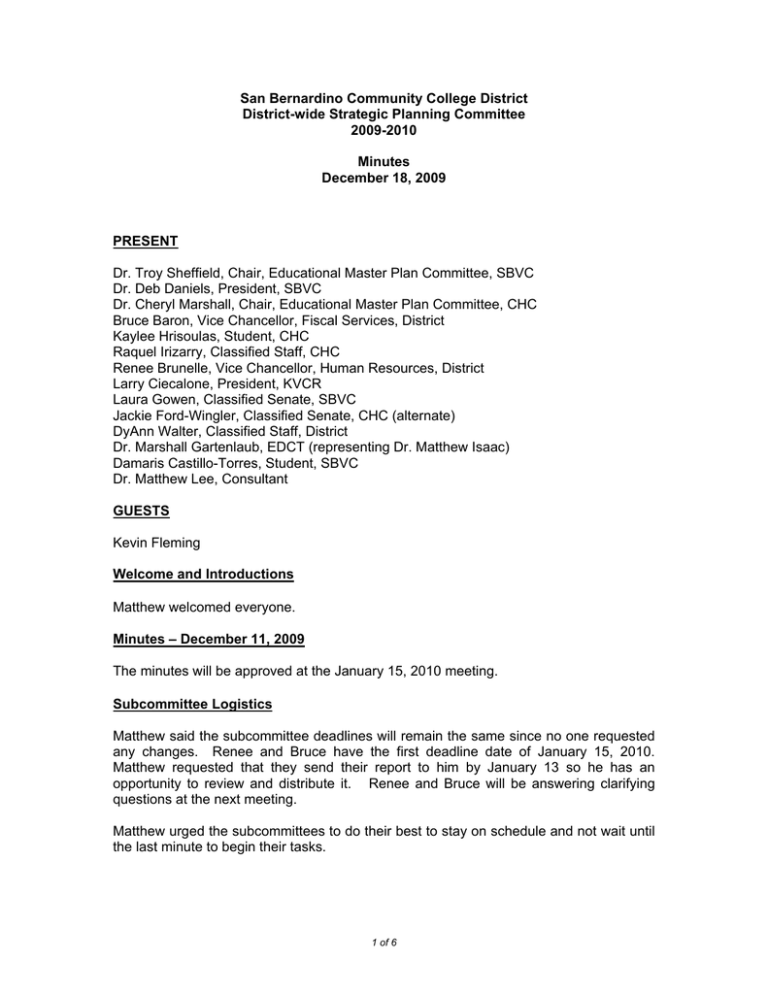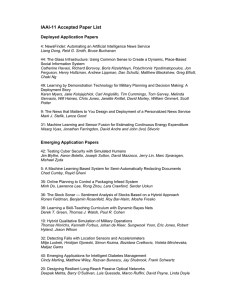San Bernardino Community College District District-wide Strategic Planning Committee 2009-2010
advertisement

San Bernardino Community College District District-wide Strategic Planning Committee 2009-2010 Minutes December 18, 2009 PRESENT Dr. Troy Sheffield, Chair, Educational Master Plan Committee, SBVC Dr. Deb Daniels, President, SBVC Dr. Cheryl Marshall, Chair, Educational Master Plan Committee, CHC Bruce Baron, Vice Chancellor, Fiscal Services, District Kaylee Hrisoulas, Student, CHC Raquel Irizarry, Classified Staff, CHC Renee Brunelle, Vice Chancellor, Human Resources, District Larry Ciecalone, President, KVCR Laura Gowen, Classified Senate, SBVC Jackie Ford-Wingler, Classified Senate, CHC (alternate) DyAnn Walter, Classified Staff, District Dr. Marshall Gartenlaub, EDCT (representing Dr. Matthew Isaac) Damaris Castillo-Torres, Student, SBVC Dr. Matthew Lee, Consultant GUESTS Kevin Fleming Welcome and Introductions Matthew welcomed everyone. Minutes – December 11, 2009 The minutes will be approved at the January 15, 2010 meeting. Subcommittee Logistics Matthew said the subcommittee deadlines will remain the same since no one requested any changes. Renee and Bruce have the first deadline date of January 15, 2010. Matthew requested that they send their report to him by January 13 so he has an opportunity to review and distribute it. Renee and Bruce will be answering clarifying questions at the next meeting. Matthew urged the subcommittees to do their best to stay on schedule and not wait until the last minute to begin their tasks. 1 of 6 Review of and Clarifying Questions on Distributed Documents Matthew asked if there were any clarifying questions regarding documents 4I, 4J, or 4K. No one had any questions. Matthew did a brief run-through of the handouts. Matthew prepared an edited transcript of the posted comments made at the December 11 meeting (4I) on the potential implications of the CCC Strategic Plan and the ARCC data for District strategic planning. The committee can refer back to this document as needed later in the process. Committee members can bring any questions or comments they have about this document to the next meeting. The bracketed numbers refer to the suggested District strategic goals in the Working Set of District Strategic Directions and Goals (4J) that appear to be related. Matthew asked the committee to read the first three paragraphs of the Working Set (4J), which describe the intent of the Working Set, and gave them a few minutes to do so. This draft is built from the existing Board Imperatives, which we are required to build into the Plan, and the existing goals at each of the colleges. The Accrediting Commission’s recommendation requires the District Strategic Plan to receive input from the college plans, to align with the colleges’ plans, and when the Plan is finished in the spring, to guide planning at the college level. Matthew asked if there were any clarifying questions about the intent of 4J. There was none. He said that committee members need to review this document in detail so we can discuss it at the next meeting. Matthew asked Kay Ragan and Cheryl Marshall to answer a few questions regarding enrollment management practices that might have an effect on strategic planning (4K). Matthew thanked Kevin for taking on the environmental scanning tasks for this first phase of District strategic planning, and noted that documents 4L were provided courtesy of Kevin. The first three documents presented service areas based on student enrollment data. Troy, Cheryl, Kevin and Matthew met to define operationally the service areas of the colleges and the district. Their definition of each college’s service area includes all zip code areas with at least 0.5% of enrolled students in that college over the last three years. The district service area is a combination of the service areas of both colleges. The legends indicate how many students are in these areas. There is considerable overlap of the two colleges in the district service area. The SBCCD Service Area vs. Legally Defined Boundary map shows the service area of the district as a whole laid out with the various neighboring community colleges’ district boundaries. The last map shows the median age of the population in each zip code of the SBCCD service area. Kevin will be doing some additional demographic reports. The committee will be looking at age, ethnicity and other demographics in January. Matthew asked if there were any clarifying questions. There were no clarifying questions. Matthew thanked Kevin again for producing this information. Matthew asked if there were any clarifying questions in the homework packets (4A-4H). He talked about 4D and 4E briefly and went over the colleges’ Annual Planning Longitudinal Data. Matthew explained that the Chancellor’s Office Long Range 2 of 6 Enrollment and WSCH Forecast projections from 2008 on are based on the average of the last three years of actual enrollments. Bruce said we are expecting to have more FTES than last year because we are putting more people in classes. He added that the budget restraints will hit us next year, and he didn’t see the numbers increasing to the same degree next year. Matthew said the information in the Chancellor’s report is useful but limited, and advised the committee members to consider the context any time they are looking at data. There were no questions. BREAKOUT The four breakout groups discussed the implications of these documents for strategic planning in the district. See Edited Transcript of Posted Comments, December 18, 2009 for the recorded results of the groups’ discussions. Group A – Bruce/Demaris/Raquel This group discussed the implications of the District and College Foundational Statements (4A) and Board Imperatives and Institutional Goals (4B) on strategic planning in the district. Group A – Comments Damaris reported that most of this group’s items have to do with how things are defined and measured. • How do we know students are returning? • How is improvement measured? • Does lifelong learning mean we are taking classes all the time or that we are encouraging such things as reading, for example? • Not all students see a counselor to obtain an educational plan. We can make it mandatory to see a counselor. What are the students interested in? What do they need? An educational plan could help with their success. Faculty and staff could volunteer to answer students’ questions. • How do we constantly maintain the curriculum that serves the needs of the communities? • Instructors should be held accountable for the success of their students. If half the class is failing, perhaps we need to look at what is happening in that classroom; perhaps learning styles are not matching the instructor’s approach. • How about a commitment to increasing alternative revenue streams, i.e., partnerships. Find other ways to get money. Group B – Troy/Deb This group discussed the implications of the Accrediting Commission’s Rubric for Evaluating Institutional Effectiveness—Part II: Planning (4C) on strategic planning in the district. 3 of 6 Group B – Comments Troy noted that it might be interesting to distribute the ACCJC Planning Rubric to the sites so they can check off how we are doing. Are we meeting the requirements? • There is an expectation of dialogue in this rubric, but what evidences are there at the district that this is occurring? What does district dialogue look like? How does it occur? • There should be more emphasis on how plans and projects impact student learning. Perhaps we could add the impact on student learning to a board document. • What does transparency look like? That has to be reflected in the document and goals for the district. • Evaluate actions and results so that we know how we need to improve. Then reevaluate to see if that change resulted in improvement. What do they mean by a cycle of evaluation and are we doing that? • Regarding the program review process, what did we not ask? Using the information gathered in program review, did we improve? • How about broad-based planning? When you do anything, there needs to be an audit or a debriefing. How did a major activity occur? Evaluate that activity. What could we improve? Re-evaluate to get to the cycle of improvement. • We ought to use the terms used by the ACCJC documents and rubrics. Matthew said transparency and communication fit well under suggested District Strategic Goal 1.1, and would facilitate integration of district and college planning. One or more concrete objectives on these issues under Goal 1.1 would help. Group C – Kevin/Marshall/Jackie/Larry/Renee This group discussed the implications of the Job Projections by Industry, 2008-2013 (4D) and the Occupational Projections, 2008-2013 (4E) on strategic planning in the district. Group C – Comments Marshall said that if you ask students why they want go to college, they say it is to get a better job. • We have five major industries in our communities with a large increase in hiring. We should make an effort to build partnerships in these areas. We should be marketing and advertising in these industries saying we can support them and tell our students that these are the industries that are available locally. We recommend we look at a line of resources to support the largest growth areas in the district. • Out of the top-growing 50 jobs in this area, 34 require less than a 4-year degree. Many of them require only on-the-job-training. There is a lot of opportunity for the colleges to participate in “not for credit” training. Many of these jobs paid a living wage. 33 of the 34 could be done with a certificate or “not for credit” training. • We could align ourselves with industry standards. • There are alternative resources we could get to help in these efforts. For example, if an industry feels supported, they are open to internships. We need to think outside of the traditional classroom. 4 of 6 Group D – Kaylee/Cheryl/DyAnn This group discussed the implications of the enrollment management data in the colleges’ Annual Planning Longitudinal Data (4F and 4G), the Chancellor’s Office Long Range Enrollment and WSCH Forecast, 2008 (4H), and Enrollment Management Q&A with the Vice Presidents of Instruction (4K) on strategic planning in the district. Group D – Comments • • • • • • • • • Cheryl noted that both colleges have had increases in classes and FTES and along with that came an increase in productivity. An increase in costs came with more students and sections. The implications of more students could impact the quality of instruction. How do we maintain the quality of instruction? We have had a decrease in faculty load—maybe due to the SERP. Both colleges have good retention and pass rates. Maybe we could share how each college is accomplishing this. We need to balance cost with growth because of the increase in enrollment. We think some growth will continue but demand will increase. We want to continue our strategies for retention and persistence. When the economy goes down, people tend to return to school. Students who don’t graduate from high school and do not have a high school degree work on a degree or a certificate. We looked at the fact that no matter what industry you work in, there is a need for the basic skills like critical thinking. There are implications that we need to balance online programs with face-toface. Online programs increase access, but the problem with online programs is you tend to have lower retention and success. They tend to fill up first, but you have fewer students that make it through. We need to look at weekend programs and services, but costs tend to increase for those programs and services. We need to look at how we can achieve this. How do we meet the needs of a non-traditional student? We need to look at where we want to grow. Look at different ways to get faculty to teach classes differently, like teaching a large class. Think outside the box. How do we pay faculty and staff to use some different kinds of structure? Matthew said further development of research capacity would help greatly in answering many of these questions; perhaps that should be an objective under suggested District Strategic Goal 1.1 or 3.3. HOMEWORK Matthew will do an edited version of the posted comments, as before. Additional environmental scanning results will be coming out if they are available. The first subcommittee report will be presented at the next meeting. 1. 2. 3. Continue subcommittee work. Review the Working Set of District Strategic Directions and Goals (4J). Review additional environmental scan results (to be distributed January 13 if available). 5 of 6 4. Review summary tables for effectiveness and impact indicators (to be distributed). Matthew wished everyone a great holiday. Jackie Buus Recording Secretary 6 of 6

